



Mitsubishi Mirage Cyborg - R
Rise of the Cyborg
In my search for
more performance
from the
Proton Satria race car I had stumbled across the JDM (Jap Domestic
Market)
Mitsubishi Colt/Mirage Cyborg that is fitted with the MIVEC (4G92)
engine.
A revy little 1.6 that was optimistically rated at 175bhp at 7500rpm and continues to
spin into the 8k's,
though real world figures have it at a more realistic 150bhp to 160bhp.
As this is the car that Proton later bought the body rights to major
components
interchange
You only need a Engine, ancillaries, loom, ECU and ideally Gearbox to
make the most of the package.
Finding the bits was another matter, a complete car advertised for
quite some time on one of the Colt forums, way up in Sterling with
dubious black roof & bonnet putting most people off making the
journey to view, a deal was struck and off I went on a train to Bonny
Scotland.
Having a complete car meant a few of options, break the Cyborg and fit
the
engine in the Satria, sell the Satria race ready and build the Colt, or
break the Satria, keep the race bits and sell off the rest.
Breaking the Satria was the winning option, despite having to take a
bit of a bath, it was probably more cost effective than trying to sell
the Satria in a deflated market and ending up
with 2 race cars.
Plus it would give a stock of mechanical spares and sell off other bits.
Since December 2010 I have built and continued to improve the car...
February 2012 - Windscreens & Wheel Bearings
December 2011 - Torsen LSD
September
2011 - New Suspension
July 2011 -
Gearbox Rebuild
April 2011
- First Test
March 2011
- Paint & Assembly
February
2011 - The Preparation
January
2011 - The Stripping
December
2010 - The Purchase
The changes made some significant improvement to the Mirage at Silverstone, we have now sold the Mirage and will be racing a Nissan Pulsar GTI-R in 2013
I had planned a couple of jobs after Castle Combe, the car has been much better with some recent changes to the suspension set up, I planned to change the front anti-roll bar for a smaller diameter one to try at Anglesey. This was for 2 reasons, last year at Anglesey I really struggled with understeer, so would be an ideal test bed, added to that the Anglesey race is my only one with CSCC this year, so if it is a backwards step I have not effected my running for the Red Dragon class award for 2012.
It is a bit of a pain to swap as the subframe needs to come down and I had to re-set the camber & tracking after.
The factory Mirage Cyborg ARB / Sway Bar is 23mm, the one I am trialing is 18mm, the pick up points are slightly different , so I will be using the Lancer Evo mounts on the struts
While the crossmember was off, I took the opportunity of fitting Lancer Evo solid lower engine mountings.
As usual, the best laid plans... I picked up a little bit of damage from an other car during qualifying, it did leave a little damage on the tyre, but nothing to render it dangerous, I removed the damaged stickers and buffed off the offending paint & rubber marks, organised some replacement stickers and we are good to go !
While we were at Castle Combe I took the opportunity of weighing the car, post race we were 985kg (inc me & fuel), I have a few plans to get the car into the GT200 class over winter, so it will require me to carry some ballast as the class limit for GT200 is now 1010kg.
Pre-season check over cast some doubt on the N/S front wheel bearing, though this is the most loaded due to the majority of UK tracks being clockwise I took the decision to change both sides. Another job on the to do list was have a new windscreen fitted, an errant stone last season had caused a chip and the crack had been growing. Local company Auto Aid came out and fitted one.
As with many FWD cars I have been
suffering with a loss of traction on the unloaded front wheel in
corners. The plan being to fit an LSD before the 2012 season. A Torsen
type LSD from a later Cyborg came up, a new paddle clutch will also be
fitted.

We started to develop the suspension further, this resulted in changing the old Coil overs to some new BC Racing RM Series coil overs, finishing off polybushing the many suspension arms and fitting some new rear Camber and Toe arms for finer adjustment . We ran these for the first time at the DTM support race at Brands.
With no baseline I qualified on them too soft, after talking to the guys from Tengu Do Motorsport, I raced with them on much better setting, I am still suffering from a bit of understeer, but much better than before.
In the post race check over, I was surprised and disappointed to see the Mintex M1166 brake pads on the front down to just a few mm. with a shortened season for me this year I was expecting much better wear as I have effectivley only done 1/3rd of a season and no testing.
I have decided to go back to Carbotech XP8, I ran these on the heavier MR2 and apart from being exceptional pads, they were lasting 1.5 seasons.
Having run the first race at Donnington on the old Proton gearbox due to the worn syncro, I was keen to overhaul the Cyborg gearbox as the longer final drive of the Proton box does not suit the Cyborg.
We took the Cowborg to Oulton Park for a track day shake down, very pleased with the car overall, though I did suffer a worn 3rd gear syncro.
I do plan to change the springs to as we had a bit too much roll. I managed a 40 min stint in the afternoon which was good for simulating the CSCC races
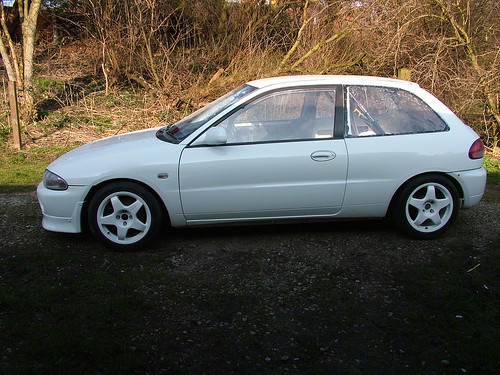
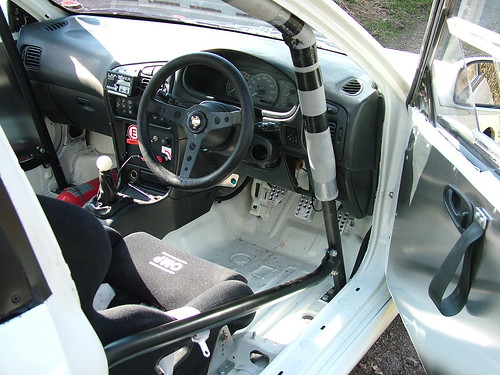
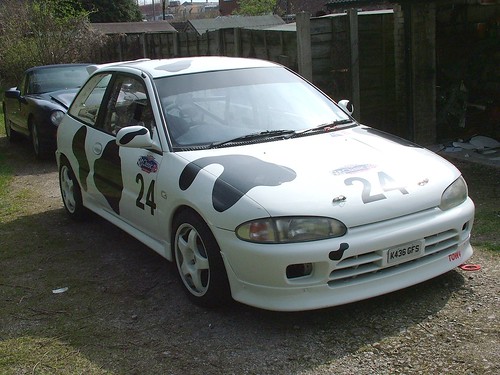
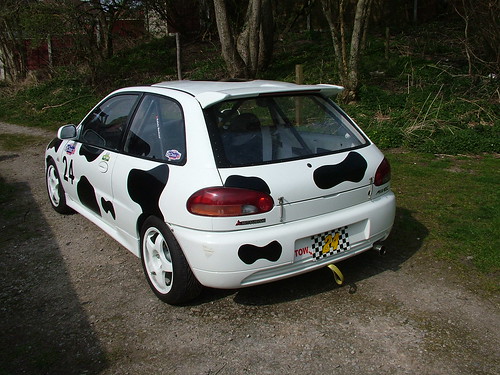
Tacked the plates
with the cage all bolted up
Cage out and seam welded the mounts and plugged some of the redundant
trim holes
Welded seat plates in and mounts for the 5th & 6th part of the
harness
Painted the Interior
The on to prepping the exterior for paint
January 2011
Removed the front section of the cage, the rear is loose, but as it's
bulky can live in there for now.
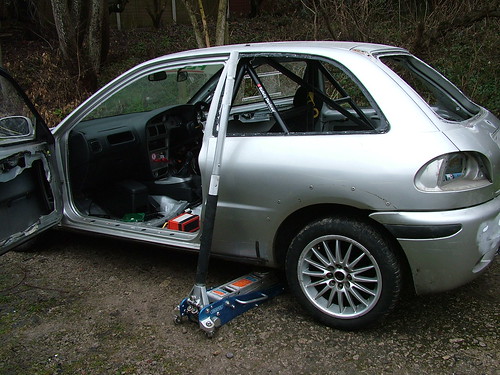
Bolted in the cage ready to weld the floor plates in, these are on
order with Safety Devices
I didn't want to start hacking them out of the old shell, or
particularly wanted to make my own.
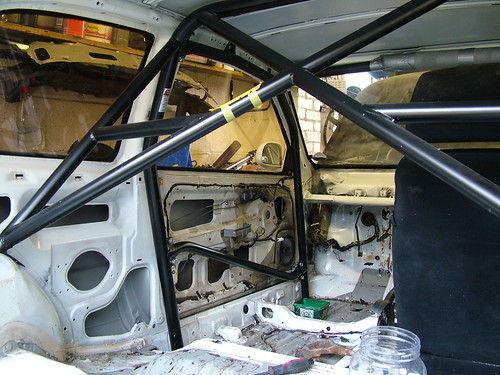
I'm currently on track for having the Satria stripped enough to get rid
of the shell at the end of Jan

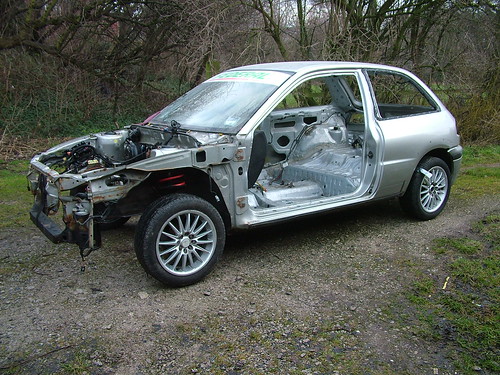
Tucked up in the
garage the morning after the road trip
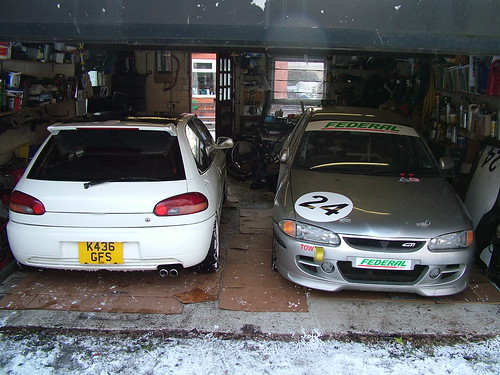
Soundproofing comes off so much easier when it's -5 inside the garage !
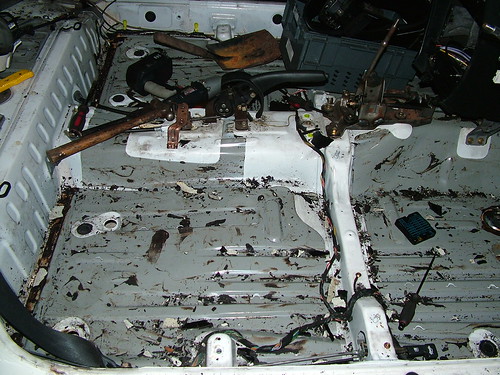
Changed over the coilovers onto the Colt

Not a great fan of alloy crank pulleys so I will swop that for a std one
Front brakes are Evo 3 with Mintex 1166 and the rears are std with
Mintex 1144's
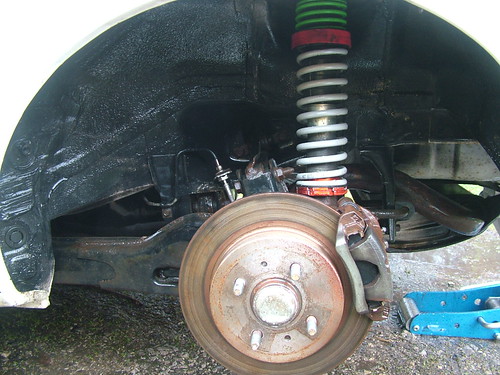
Removed the dash assembly to get the sound proofing off the bulkhead
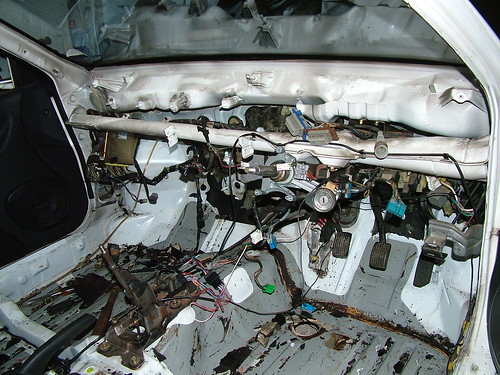
Finished removing the remainder of the floor soundproofing
The car is/was fitted with Climate Control.
The A/C side having been removed previously including the evaporator,
but everything else was functioning
While all the whole assembly was out (except the matrix) I weighed it,
a smidge under 6kg, I can live with that.
In 1991, the 4th Generation or 'CC' chassis platform changed to a modern more stylish rounder shape to its predecessors. A two-door coupe was introduced based on the Colt (the Asti in Japan) and sold outside Japan to a number of countries around the world as the 'CC' chassis Colt (in New Zealand and United States), and the Lancer coupe in Australia. These deliveries mainly saw a Front wheel drive 1500 cc 8 valve SOHC caburettor engine in the base GL model, or a 1800 cc SOHC 8 valve EFI engine in the higher GLXi variant in Australia, and the same engines were offered in New Zealand and overseas but in a choice of either Front Wheel Drive or All wheel drive variant, and either a 2-door, 3-door (Cyborg) or 4-door shape. This is where the first MIVEC 1600 cc engines started to roll out in Mitsubishi platforms. The 2-door CC coupe was sold with the CA5A chassis description. Mitsubishi's engine choices were vast with this new platform. Their most popular were the 4G15 1.5 Carburetor, 4G15 1.5 fuel injected, 4G93 1.8 EFI, 4G93 1.8 DOHC EFI, 4G92 1.6 MIVEC EFI, a 4G91 1.8 DOHC caburetor, and even a 6A10 (V6)and 4D68 Turbo Diesel all in either a front wheel drive or All Wheel Drive format. The 2.0 L 4G63 turbo was an option only in the U.S., but was quickly dropped in favor of using this power option in the soon to be released Lancer Evolution I.
Proton took over the license to this design for its range from 1997 onwards and it is still offered in some countries as the Proton Satria (three-door, ex Cyborg) and Proton Wira (four and five-door), Proton M21/Putra coupe (2-door), or 200 and 400 series. Not only is the car still being built by Proton, but they also developed a pickup/ute variant of the chassis and named it the Proton Jumbuck.
Mitsubishi started manufacturing the fifth generation/CC platform in 1991, it was taken over by Proton in 1996/97 and is still being utilised in 2006.
With the split between the name Asti/Mirage/Lancer namesake spanning over several countries it created somewhat of a confusion but something that all models share is the 'CC' chassis platform. The rounder shape of the Asti/Mirage/Lancer coupe, hatch and 4 door sedan gave them a modern sportier appearance different from the squarer 'CC' chassis of the Mirage/Lancer sold alongside it in the showroom floor. These squarer 4th Generation versions of the Lancer/Mirage sedan and wagon (as pictured to the right) had the similar appearance as the popular Evolution Lancer 1-3 models which were used in rally. These models were available in sedan or wagon and either FWD or AWD. A 1800 cc DOHC Turbo 145 kW (197 PS; 194 hp) version of the Lancer Sedan was sold as the "GSR Turbo" variant in Australia and New Zealand, and the AWD turbo wagon was only available in New Zealand under the "Libero" name. These versions were based on the EVO 1-3 models, but only offered with a 1800 cc 4G93T turbo engine, not the 2000 cc 4G63T turbo engine as in the EVO models.
The MIVEC-powered Mirage Cyborg R has never been officially imported into Australia by Mitsubishi - which is a terrible shame. The local CC model Mitsus got by with an econo-derived wheezer, but the Cyborg R is the ultimate gun. It really hauls with a full 129kW on tap. Interestingly, the Japanese Mirage line-up also extends to include a 1.3 litre (58kW) pov-pack and even a 1.6 litre (107kW) 4WD version. They've a model range that sure is far greater than our's...
Next to the Mitsubishi FTO MIVEC (again, only privately imported from Japan), the Cyborg R puts up real competition to the more widely recognised VTEC-powered Hondas. And one big advantage for the Mitsubishi is its price. Side-by-side, the MMC product is always cheaper - an advantage that's usually carried over to Australian shores when you buy an import.
The Cyborg R - being the most high performance Mirage - rides on the same basic MacPherson strut suspension design as the others but, more than likely (it's a bit hard to find out all the details!) with uprated springs and dampers. The ride is firm and it can be upset by potholes and poor road surfaces, but it enjoys the same amount of ground clearance as other Mirages. And, of course, it's front wheel drive. So it handles like a traditional hot hatch with a tendency to understeer - but it's certainly not major. Careful throttle trimming will always bring the Mitsui back onto line.
There's no great shock in learning that this car scores vented disc brakes up front and solid discs under the back. It needs it: drum rear brakes are only for the pussy-engined Mirages. The car we tested didn't have an ABS system fitted (although this may be an option) and it was still shod in the Japanese mud and snow tyres - but it did pull up in a straight line.
To make this thing a real go-kart, the steering needs to be sharpened up just a bit with a quicker ratio. It isn't bad; it's just that the rest of the car is so damn inspirational! From factory, the Cyborg spins a set of 14-inch alloys with 195/60 rubber. Being only 14s, though, they don't do the car justice and a set of 15s (or larger) would be more in keeping with the character of the car.
Park it next to a garden variety Mirage and you'll appreciate how much hornier the import version looks. From its low front spoiler (with integrated fog lamps) to its side skirts and rear spoiler it's a pumped-up Mr Universe version of the Aussie Mirages - VRXs included. And being a sports model, the exterior is fully colour coded.
On the other side of those lengthy doors is a very practical yet sporty cabin that seats five. Being a Mirage it possesses good space utilisation and everything is well laid out - but it's the factory front and rear Recaro seats that impressed us. Although they're a little firm and flat across the back, they hold you in tight and let you focus on driving hard. The dash layout is very similar to the Lancer GSR's and the instrument cluster is home to something you don't see on your everyday streetcar - a tacho numbered all the way to 10,000 rpm! A climate control system is fitted too, but it took us a while to work it out (maybe we're a bit slow).
Screw every bit of the Cyborg R together and it comes up weighing 1040kg - only around 50kg more than the basic everyday model, but with 87 per cent more power than a local Mirage!
Mirages aren't noted for their potent engines. The Cyborg R changes all that in one swift charge up through the gears. We're not exaggerating, the Mirage's MIVEC engine is the best small atmo engine we've ever sat behind. It's got instant throttle response, a generous amount of low-down torque, a strong mid-range - and from about 5500 rpm up, it simply rockets. It puts out so much torque up high, you can just hold-it-hold-it-hold-it in one gear.
RaaaaaAAAAAAAA!!
So how good is it? The MIVEC engine is far more flexible than a 2.2 Honda V-TEC, for example. You never find yourself wishing it had a little more torque here or there - it's always ready and willing to pull. And willing the Cyborg R certainly is - especially in acceleration. Our timed 0-100 km/h test revealed that the little terrier could rival many "fast" cars. The needle swung past the triple digits in around 7.8 seconds - not bad at all...and with that instant throttle response it feels even faster!
The heart of this giant killer is the MIVEC (Mitsubishi Innovative Valve and Lift Electronic Control System) 4G92, using a bore and stroke of 81.0mm and 77.5mm respectively. This amounts to 1597cc and with a 11.0:1 CR, DOHC, 16 valves and EFI, it generates 129kW at 7500 revs and 167Nm at a skyward 7000. That way-high rpm at which peak torque is developed never feels like that on the road - there is always instant, strong response. How strong? Well, with the fairly slippery tyres of the test car, you could drive along at low rpm in first gear with the clutch out. Stomp on the loud pedal and the front tyres would then actually chirp on dry pavement as the torque hit!
This is one highly efficient engine - its 81kW per litre puts it way ahead of the Honda Integra VTi-R with 69 kW/litre. But, of course, you always need to feed it premium unleaded to keep it running happily. (Remember, Japanese fuel still has higher octane than even our Shell Optimax)
It's amazing how many wonderful qualities the Cyborg R has. It's a versatile sized car with ball-tearing performance - yet it still delivers around 8.5 - 9 litres per 100km fuel economy (with some enthusiastic driving too, we might add!). This is helped by the fact that all Cyborgs have a 5-speed (though non-LSD) manual transaxle.